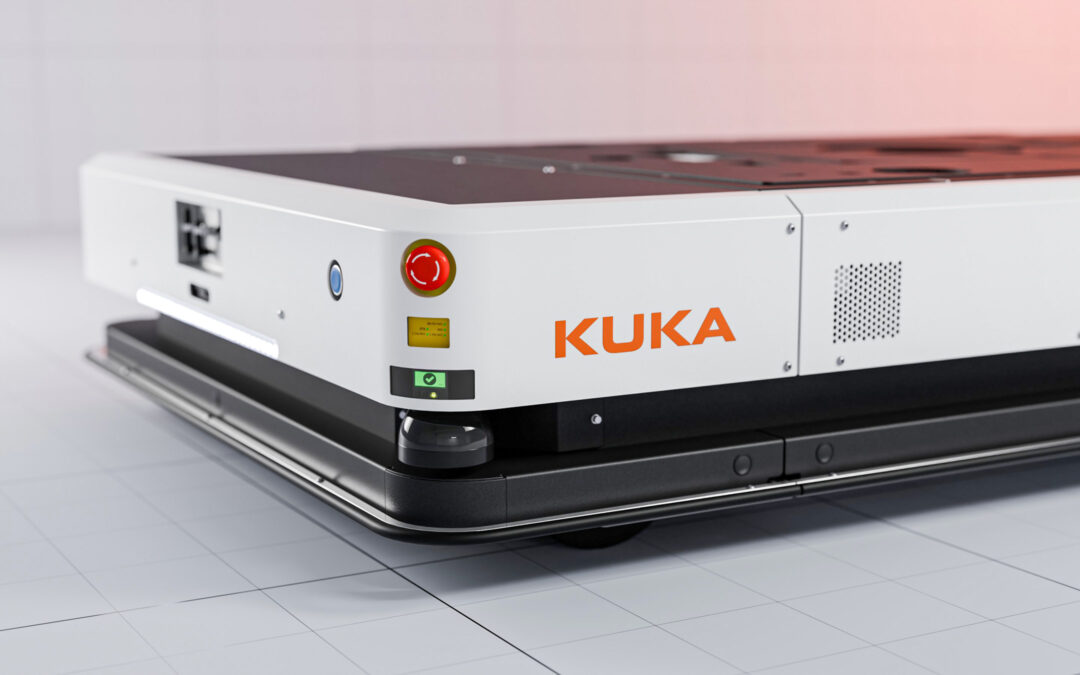Recently, FPE Automation connected our team with a heat seal packaging manufacturer looking for a solution to increase safety and labor efficiency in their facility. They needed a strategic partner capable of integrating automation products into the facility’s production and warehouse areas.
Hyperion’s team of experts rose to the challenge of designing an integration solution that incorporated AMRS for pallet replenishment, transportation of pallets and pallet wrapping that would fit seamlessly into their current operations.

The Challenge
In a production area with close working conditions between human operators and forklift traffic, improving safety and efficiency was of utmost importance to the client. OSHA estimates that approximately 97,000 injuries related to forklifts occur annually, including 35,000 serious and 62,000 non-serious injuries. This poses a significant safety risk in production facilities. Our client’s goal was to significantly reduce forklift traffic in the production area and isolate it solely to the warehouse.
The Solution
The process began with Hyperion application engineers conducting a feasibility assessment of the production area to determine the space necessary for the AMRs to operate safely and efficiently. In the production area, machinery produces the heat-sealed packaging products and then places the product into boxes. Simultaneously, the completed products emerge on a conveyor where human operators palletize the boxes by hand. At this point in the process, a forklift driver would be notified by a team member to drive to the station and pick up the pallet, navigating a unique route among machines, human operators, and other forklifts each time a pallet is ready to move to the next phase of production.
In order to eliminate the traffic of forklifts transporting pallets, we needed to integrate AMRs, a custom-designed AMR pallet stand, and a pallet destacker into the existing layout of their warehouse.
In collaboration with PALOMAT, we sourced a pallet magazine to efficiently and safely streamline the lifting and lowering of pallets onto an AMR, improving both pallet replenishment and transportation.
The Process
1. The MiR 1350 AMR paired with the MiR 1350 Pallet Lift top module first visits the pallet magazine where the bottom pallet separates from the stack. Driving under the stack of pallets, the AMR can now pick up the bottom pallet.
2. The AMR drives out from underneath the pallet destacker with the single pallet, and arrives at the pallet stand where it places the single, empty pallet onto the stand.
3. The human operator places the boxes of product onto the pallet, completing a pallet weighing up to 1800 pounds.
4. Once the operator finishes stacking boxes onto the pallet, they use a tablet equipped with MiR Fleet Server Communication. At the press of a button, the navigation and planning software communicates to the AMR to return to the pallet stand and collect the pallet.
5. Arriving back at the pallet stand, the AMR drives underneath, lifting the pallet to take it to the next process in the warehouse.
6. To enable successful pallet transportation, the AMR communicates with the overhead door using wireless communication to pass through. It enters the warehouse where the pallet will be wrapped to prepare for distribution.
7. Once inside the warehouse, the AMR drives into the custom AMR-compatible U-shape docking conveyor in the “up” position with the pallet raised.
8. The AMR lowers the MiR1350 pallet lift, setting the pallet on the two-strand chain conveyor.
9. The lift continues to lower down until there is clearance between the lift and the pallet, allowing the AMR to depart.
10. The chains move forward to move the pallet into the wrapping system to prepare for distribution.
11. The pallet indexes forward into the wrapping system, which wraps the pallet according to the tension requirements based on the load weight, ensuring it can support the load effectively.
12. The wrapped pallet indexes out of the wrapper system onto a five-zone outfeed conveyor, also known as “the buffer”. This zone allows fully palletized products to accumulate while the system maintains its pace and wraps additional pallets.
13. The buffer enables the system to complete six zones before a forklift driver needs to unload pallets from the system and transport them as a finished group to the loading zone.
The Results
Through strategic collaboration with trusted partners, our team was able to successfully reconfigure the client’s existing workflow into a combination automation-operator solution. This turnkey application led to:
An increase in labor efficiency. With the consistency of a programmed AMR system functioning throughout the facility, operators are now able to optimize the timing of tasks instead of waiting for pallets to be ready for transportation. In addition, integrating a pallet magazine into the production process allows for automatic pallet replenishment, eliminating the task of someone manually unstacking pallets each time a new one is needed.
An increase in safety through the balance of operators and technology. Our solution greatly increases workplace safety by eliminating potentially dangerous forklift traffic from the production space and replacing it with a programmed AMR system designed for reliable collaboration with human operators.
An increase in consistency and quality. As the AMR completes tasks with accuracy, our client experiences full control over fewer system variables with each pallet, optimizing the consistency and speed of workflow.
Partner with Hyperion
If you have a complex integration project, our team of experts is always up for the challenge. With our portfolio of innovative tools and solutions, we are committed to designing a solution that meets your most unique needs.



